Chapter 10: Emotion and Motivation
Introduction
What makes us behave as we do? What drives us to eat? What drives us toward sex? Is there a biological basis to explain the feelings we experience? How universal are emotions?
In this chapter, we will explore issues relating to both motivation and emotion. We will begin with a discussion of several theories that have been proposed to explain motivation and why we engage in a given behavior. You will learn about the physiological needs that drive some human behaviors, as well as the importance of our social experiences in influencing our actions.
Next, we will consider both eating and having sex as examples of motivated behaviors. What are the physiological mechanisms of hunger and satiety? What understanding do scientists have of why obesity occurs, and what treatments exist for obesity and eating disorders? How has research into human sex and sexuality evolved over the past century? How do psychologists understand and study the human experience of sexual orientation and gender identity? These questions—and more—will be explored.
This chapter will close with a discussion of emotion. You will learn about several theories that have been proposed to explain how emotion occurs, the biological underpinnings of emotion, and the universality of emotions.
Motivation
Learning Objectives
By the end of this section, you will be able to:
- Define intrinsic and extrinsic motivation
- Understand that instincts, drive reduction, self-efficacy, and social motives have all been proposed as theories of motivation
- Explain the basic concepts associated with Maslow’s hierarchy of needs
Why do we do the things we do? What motivations underlie our behaviors? Motivation describes the wants or needs that direct behavior toward a goal. In addition to biological motives, motivations can be intrinsic (arising from internal factors) or extrinsic (arising from external factors) (Figure 10.2). Intrinsically motivated behaviors are performed because of the sense of personal satisfaction that they bring, while extrinsically motivated behaviors are performed in order to receive something from others.
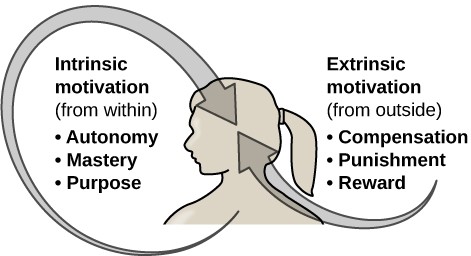
Figure 10.2 Intrinsic motivation comes from within the individual, while extrinsic motivation comes from outside the individual.
Think about why you are currently in college. Are you here because you enjoy learning and want to pursue an education to make yourself a more well-rounded individual? If so, then you are intrinsically motivated. However, if you are here because you want to get a college degree to make yourself more marketable for a high-paying career or to satisfy the demands of your parents, then your motivation is more extrinsic in nature.
In reality, our motivations are often a mix of both intrinsic and extrinsic factors, but the nature of the mix of these factors might change over time (often in ways that seem counter-intuitive). There is an old adage: “Choose a job that you love, and you will never have to work a day in your life,” meaning that if you enjoy your occupation, work doesn’t seem like . . . well, work. Some research suggests that this isn’t necessarily the case (Daniel & Esser, 1980; Deci, 1972; Deci, Koestner, & Ryan, 1999). According to this research, receiving some sort of extrinsic reinforcement (i.e., getting paid) for engaging in behaviors that we enjoy leads to those behaviors being thought of as work no longer providing that same enjoyment. As a result, we might spend less time engaging in these reclassified behaviors in the absence of any extrinsic reinforcement. For example, Odessa loves baking, so in her free time, she bakes for fun. Oftentimes, after stocking shelves at her grocery store job, she often whips up pastries in the evenings because she enjoys baking. When a coworker in the store’s bakery department leaves his job, Odessa applies for his position and gets transferred to the bakery department. Although she enjoys what she does in her new job, after a few months, she no longer has much desire to concoct tasty treats in her free time. Baking has become work in a way that changes her motivation to do it (Figure 10.3). What Odessa has experienced is called the overjustification effect—intrinsic motivation is diminished when extrinsic motivation is given. This can lead to extinguishing the intrinsic motivation and creating a dependence on extrinsic rewards for continued performance (Deci et al., 1999).

Figure 10.3 Research suggests that when something we love to do, like icing cakes, becomes our job, our intrinsic and extrinsic motivations to do it may change. (credit: Agustín Ruiz)
Other studies suggest that intrinsic motivation may not be so vulnerable to the effects of extrinsic reinforcements, and in fact, reinforcements such as verbal praise might actually increase intrinsic motivation (Arnold, 1976; Cameron & Pierce, 1994). In that case, Odessa’s motivation to bake in her free time might remain high if, for example, customers regularly compliment her baking or cake decorating skills.
These apparent discrepancies in the researchers’ findings may be understood by considering several factors. For one, physical reinforcement (such as money) and verbal reinforcement (such as praise) may affect an individual in very different ways. In fact, tangible rewards (i.e., money) tend to have more negative effects on intrinsic motivation than do intangible rewards (i.e., praise). Furthermore, the expectation of the extrinsic motivator by an individual is crucial: If the person expects to receive an extrinsic reward, then intrinsic motivation for the task tends to be reduced. If, however, there is no such expectation, and the extrinsic motivation is presented as a surprise, then intrinsic motivation for the task tends to persist (Deci et al., 1999).
In educational settings, students are more likely to experience intrinsic motivation to learn when they feel a sense of belonging and respect in the classroom. This internalization can be enhanced if the evaluative aspects of the classroom are de-emphasized and if students feel that they exercise some control over the learning environment. Furthermore, providing students with activities that are challenging, yet doable, along with a rationale for engaging in various learning activities can enhance intrinsic motivation for those tasks (Niemiec & Ryan, 2009). Consider Hakim, a first-year law student with two courses this semester: Family Law and Criminal Law. The Family Law professor has a rather intimidating classroom: He likes to put students on the spot with tough questions, which often leaves students feeling belittled or embarrassed. Grades are based exclusively on quizzes and exams, and the instructor posts results of each test on the classroom door. In contrast, the Criminal Law professor facilitates classroom discussions and respectful debates in small groups. The majority of the course grade is not exam-based, but centers on a student-designed research project on a crime issue of the student’s choice. Research suggests that Hakim will be less intrinsically motivated in his Family Law course, where students are intimidated in the classroom setting, and there is an emphasis on teacher-driven evaluations. Hakim is likely to experience a higher level of intrinsic motivation in his Criminal Law course, where the class setting encourages inclusive collaboration and a respect for ideas, and where students have more influence over their learning activities.
THEORIES ABOUT MOTIVATION
William James (1842–1910) was an important contributor to early research into motivation, and he is often referred to as the father of psychology in the United States. James theorized that behavior was driven by a number of instincts, which aid survival (Figure 10.4). From a biological perspective, an instinct is a species-specific pattern of behavior that is not learned. There was, however, considerable controversy among James and his contemporaries over the exact definition of instinct. James proposed several dozen special human instincts, but many of his contemporaries had their own lists that differed.
A mother’s protection of her baby, the urge to lick sugar, and hunting prey were among the human behaviors proposed as true instincts during James’s era. This view—that human behavior is driven by instincts—received a fair amount of criticism because of the undeniable role of learning in shaping all sorts of human behavior. In fact, as early as the 1900s, some instinctive behaviors were experimentally demonstrated to result from associative learning (recall when you learned about Watson’s conditioning of fear response in “Little Albert”) (Faris, 1921).
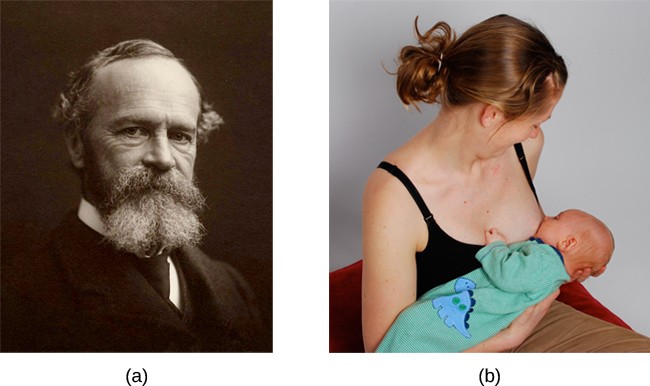
Figure 10.4 (a) William James proposed the instinct theory of motivation, asserting that behavior is driven by instincts. (b) In humans, instincts may include behaviors such as an infant’s rooting for a nipple and sucking. (credit b: modification of work by “Mothering Touch”/Flickr)
Another early theory of motivation proposed that the maintenance of homeostasis is particularly important in directing behavior. You may recall from your earlier reading that homeostasis is the tendency to maintain a balance, or optimal level, within a biological system. In a body system, a control center (which is often part of the brain) receives input from receptors (which are often complexes of neurons). The control center directs effectors (which may be other neurons) to correct any imbalance detected by the control center.
According to the drive theory of motivation, deviations from homeostasis create physiological needs. These needs result in psychological drive states that direct behavior to meet the need and, ultimately, bring the system back to homeostasis. For example, if it’s been a while since you ate, your blood sugar levels will drop below normal. This low blood sugar will induce a physiological need and a corresponding drive state (i.e., hunger) that will direct you to seek out and consume food (Figure 10.5). Eating will eliminate the hunger, and, ultimately, your blood sugar levels will return to normal. Interestingly, drive theory also emphasizes the role that habits play in the type of behavioral response in which we engage. A habit is a pattern of behavior in which we regularly engage. Once we have engaged in a behavior that successfully reduces a drive, we are more likely to engage in that behavior whenever faced with that drive in the future (Graham & Weiner, 1996).

Figure 10.5 Hunger and subsequent eating are the result of complex physiological processes that maintain homeostasis. (credit “left”: modification of work by “Gracie and Viv”/Flickr; credit “center”: modification of work by Steven Depolo; credit “right”: modification of work by Monica Renata)
Extensions of drive theory take into account levels of arousal as potential motivators. As you recall from your study of learning, these theories assert that there is an optimal level of arousal that we all try to maintain (Figure 10.6). If we are underaroused, we become bored and will seek out some sort of stimulation. On the other hand, if we are overaroused, we will engage in behaviors to reduce our arousal (Berlyne, 1960). Most students have experienced this need to maintain optimal levels of arousal over the course of their academic career. Think about how much stress students experience toward the end of spring semester. They feel overwhelmed with seemingly endless exams, papers, and major assignments that must be completed on time. They probably yearn for the rest and relaxation that awaits them over the extended summer break. However, once they finish the semester, it doesn’t take too long before they begin to feel bored. Generally, by the time the next semester is beginning in the fall, many students are quite happy to return to school. This is an example of how arousal theory works.
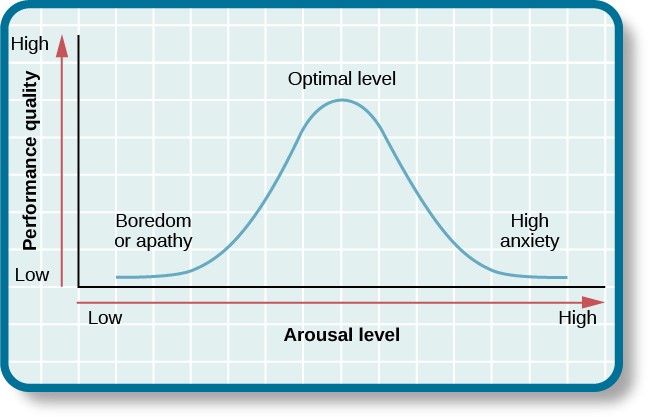
Figure 10.6 The concept of optimal arousal in relation to performance on a task is depicted here. Performance is maximized at the optimal level of arousal, and it tapers off during under- and overarousal.
So what is the optimal level of arousal? What level leads to the best performance? Research shows that moderate arousal is generally best; when arousal is very high or very low, performance tends to suffer (Yerkes & Dodson, 1908). Think of your arousal level regarding taking an exam for this class. If your level is very low, such as boredom and apathy, your performance will likely suffer. Similarly, a very high level, such as extreme anxiety, can be paralyzing and hinder performance. Consider the example of a softball team facing a tournament. They are favored to win their first game by a large margin, so they go into the game with a lower level of arousal and get beat by a less skilled team.
But optimal arousal level is more complex than a simple answer that the middle level is always best. Researchers Robert Yerkes (pronounced “Yerk-EES”) and John Dodson discovered that the optimal
arousal level depends on the complexity and difficulty of the task to be performed (Figure 10.7). This relationship is known as Yerkes-Dodson law, which holds that a simple task is performed best when arousal levels are relatively high and complex tasks are best performed when arousal levels are lower.
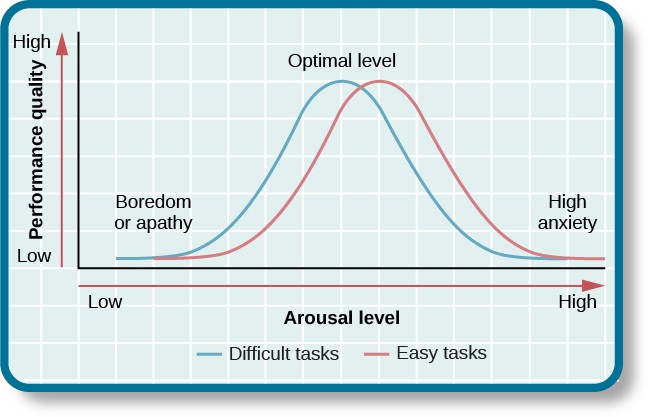
Figure 10.7 Task performance is best when arousal levels are in a middle range, with difficult tasks best performed under lower levels of arousal and simple tasks best performed under higher levels of arousal.
Self-efficacy and Social Motives
Self-efficacy is an individual’s belief in her own capability to complete a task, which may include a previous successful completion of the exact task or a similar task. Albert Bandura (1994) theorized that an individual’s sense of self-efficacy plays a pivotal role in motivating behavior. Bandura argues that motivation derives from expectations that we have about the consequences of our behaviors, and ultimately, it is the appreciation of our capacity to engage in a given behavior that will determine what we do and the future goals that we set for ourselves. For example, if you have a sincere belief in your ability to achieve at the highest level, you are more likely to take on challenging tasks and to not let setbacks dissuade you from seeing the task through to the end.
A number of theorists have focused their research on understanding social motives (McAdams & Constantian, 1983; McClelland & Liberman, 1949; Murray et al., 1938). Among the motives they describe are needs for achievement, affiliation, and intimacy. It is the need for achievement that drives accomplishment and performance. The need for affiliation encourages positive interactions with others, and the need for intimacy causes us to seek deep, meaningful relationships. Henry Murray et al. (1938) categorized these needs into domains. For example, the need for achievement and recognition falls under the domain of ambition. Dominance and aggression were recognized as needs under the domain of human power, and play was a recognized need in the domain of interpersonal affection.
Maslow’s Hierarchy of Needs
While the theories of motivation described earlier relate to basic biological drives, individual characteristics, or social contexts, Abraham Maslow (1943) proposed a hierarchy of needs that spans the spectrum of motives ranging from the biological to the individual to the social. These needs are often depicted as a pyramid (Figure 10.8).
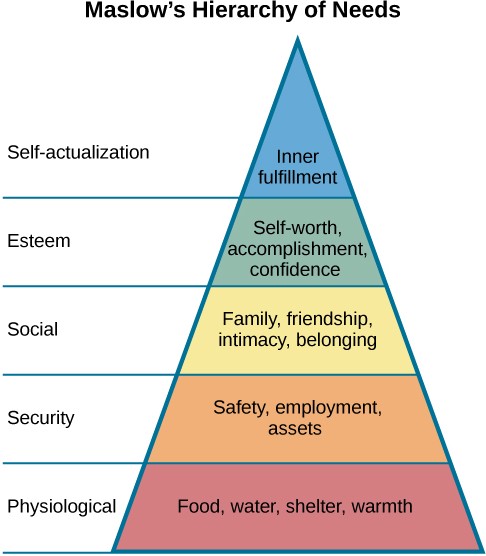
Figure 10.8 Maslow’s hierarchy of needs is illustrated here. In some versions of the pyramid, cognitive and aesthetic needs are also included between esteem and self-actualization. Others include another tier at the top of the pyramid for self-transcendence.
At the base of the pyramid are all of the physiological needs that are necessary for survival. These are followed by basic needs for security and safety, the need to be loved and to have a sense of belonging, and the need to have self-worth and confidence. The top tier of the pyramid is self-actualization, which is a need that essentially equates to achieving one’s full potential, and it can only be realized when needs lower on the pyramid have been met. To Maslow and humanistic theorists, self-actualization reflects the humanistic emphasis on positive aspects of human nature. Maslow suggested that this is an ongoing, life- long process and that only a small percentage of people actually achieve a self-actualized state (Francis & Kritsonis, 2006; Maslow, 1943).
According to Maslow (1943), one must satisfy lower-level needs before addressing those needs that occur higher in the pyramid. So, for example, if someone is struggling to find enough food to meet his nutritional requirements, it is quite unlikely that he would spend an inordinate amount of time thinking about whether others viewed him as a good person or not. Instead, all of his energies would be geared toward finding something to eat. However, it should be pointed out that Maslow’s theory has been criticized for its subjective nature and its inability to account for phenomena that occur in the real world (Leonard, 1982). Other research has more recently addressed that late in life, Maslow proposed a self-transcendence level above self-actualization—to represent striving for meaning and purpose beyond the concerns of oneself (Koltko-Rivera, 2006). For example, people sometimes make self-sacrifices in order to make a political statement or in an attempt to improve the conditions of others. Mohandas K. Gandhi, a world- renowned advocate for independence through nonviolent protest, on several occasions went on hunger strikes to protest a particular situation. People may starve themselves or otherwise put themselves in danger displaying higher-level motives beyond their own needs.
Hunger and Eating
Learning Objectives
By the end of this section, you will be able to:
- Describe how hunger and eating are regulated
- Differentiate between levels of overweight and obesity and the associated health consequences
- Explain the health consequences resulting from anorexia and bulimia nervosa
Eating is essential for survival, and it is no surprise that a drive like hunger exists to ensure that we seek out sustenance. While this chapter will focus primarily on the physiological mechanisms that regulate hunger and eating, powerful social, cultural, and economic influences also play important roles. This section will explain the regulation of hunger, eating, and body weight, and we will discuss the adverse consequences of disordered eating.
PHYSIOLOGICAL MECHANISMS
There are a number of physiological mechanisms that serve as the basis for hunger. When our stomachs are empty, they contract, causing both hunger pangs and the secretion of chemical messages that travel to the brain to serve as a signal to initiate feeding behavior. When our blood glucose levels drop, the pancreas and liver generate a number of chemical signals that induce hunger (Konturek et al., 2003; Novin, Robinson, Culbreth, & Tordoff, 1985) and thus initiate feeding behavior.
For most people, once they have eaten, they feel satiation, or fullness and satisfaction, and their eating behavior stops. Like the initiation of eating, satiation is also regulated by several physiological mechanisms. As blood glucose levels increase, the pancreas and liver send signals to shut off hunger and eating (Drazen & Woods, 2003; Druce, Small, & Bloom, 2004; Greary, 1990). The food’s passage through the gastrointestinal tract also provides important satiety signals to the brain (Woods, 2004), and fat cells release leptin, a satiety hormone.
The various hunger and satiety signals that are involved in the regulation of eating are integrated in the brain. Research suggests that several areas of the hypothalamus and hindbrain are especially important sites where this integration occurs (Ahima & Antwi, 2008; Woods & D’Alessio, 2008). Ultimately, activity in the brain determines whether or not we engage in feeding behavior (Figure 10.9).
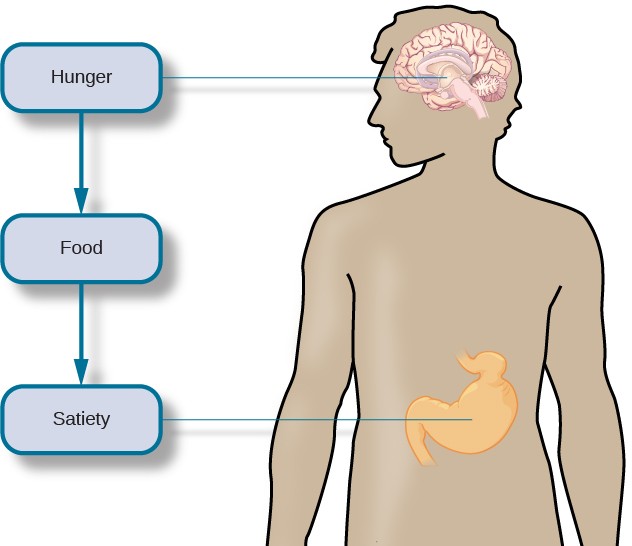
Figure 10.9 Hunger and eating are regulated by a complex interplay of hunger and satiety signals that are integrated in the brain.
METABOLISM AND BODY WEIGHT
Our body weight is affected by a number of factors, including gene-environment interactions, and the number of calories we consume versus the number of calories we burn in daily activity. If our caloric intake exceeds our caloric use, our bodies store excess energy in the form of fat. If we consume fewer calories than we burn off, then stored fat will be converted to energy. Our energy expenditure is obviously affected by our levels of activity, but our body’s metabolic rate also comes into play. A person’s metabolic rate is the amount of energy that is expended in a given period of time, and there is tremendous individual variability in our metabolic rates. People with high rates of metabolism are able to burn off calories more easily than those with lower rates of metabolism.
We all experience fluctuations in our weight from time to time, but generally, most people’s weights fluctuate within a narrow margin, in the absence of extreme changes in diet and/or physical activity. This observation led some to propose a set-point theory of body weight regulation. The set-point theory asserts that each individual has an ideal body weight, or set point, which is resistant to change. This set-point is genetically predetermined and efforts to move our weight significantly from the set-point are resisted by compensatory changes in energy intake and/or expenditure (Speakman et al., 2011).
Some of the predictions generated from this particular theory have not received empirical support. For example, there are no changes in metabolic rate between individuals who had recently lost significant amounts of weight and a control group (Weinsier et al., 2000). In addition, the set-point theory fails to account for the influence of social and environmental factors in the regulation of body weight (Martin- Gronert & Ozanne, 2013; Speakman et al., 2011). Despite these limitations, set-point theory is still often used as a simple, intuitive explanation of how body weight is regulated.
OBESITY
When someone weighs more than what is generally accepted as healthy for a given height, they are considered overweight or obese. According to the Centers for Disease Control and Prevention (CDC), an adult with a body mass index (BMI) between 25 and 29.9 is considered overweight (Figure 10.10). An adult with a BMI of 30 or higher is considered obese (Centers for Disease Control and Prevention [CDC], 2012). People who are so overweight that they are at risk for death are classified as morbidly obese. Morbid obesity is defined as having a BMI over 40. Note that although BMI has been used as a healthy weight indicator by the World Health Organization (WHO), the CDC, and other groups, its value as an assessment tool has been questioned. The BMI is most useful for studying populations, which is the work of these organizations. It is less useful in assessing an individual since height and weight measurements fail to account for important factors like fitness level. An athlete, for example, may have a high BMI because the tool doesn’t distinguish between the body’s percentage of fat and muscle in a person’s weight.
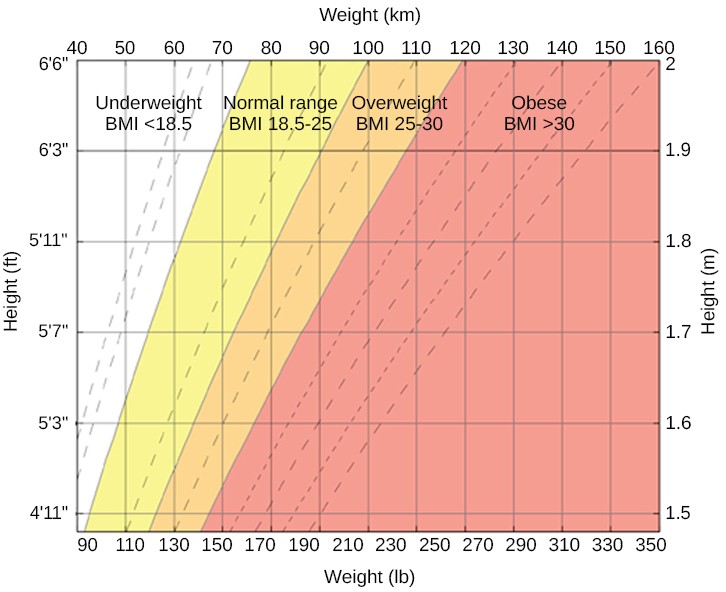
Figure 10.10 This chart shows how adult BMI is calculated. Individuals find their height on the y-axis and their weight on the x-axis to determine their BMI.
Being extremely overweight or obese is a risk factor for several negative health consequences. These include, but are not limited to, an increased risk for cardiovascular disease, stroke, Type 2 diabetes, liver disease, sleep apnea, colon cancer, breast cancer, infertility, and arthritis. Given that it is estimated that in the United States around one-third of the adult population is obese and that nearly two-thirds of adults and one in six children qualify as overweight (CDC, 2012), there is substantial interest in trying to understand how to combat this important public health concern.
What causes someone to be overweight or obese? You have already read that both genes and environment are important factors for determining body weight, and if more calories are consumed than expended, excess energy is stored as fat. However, socioeconomic status and the physical environment must also be considered as contributing factors (CDC, 2012). For example, an individual who lives in an impoverished neighborhood that is overrun with crime may never feel comfortable walking or biking to work or to the local market. This might limit the amount of physical activity in which he engages and result in an increased body weight. Similarly, some people may not be able to afford healthy food options from their market, or these options may be unavailable (especially in urban areas or poorer neighborhoods); therefore, some people rely primarily on available, inexpensive, high fat, and high calorie fast food as their primary source of nutrition.
Generally, overweight and obese individuals are encouraged to try to reduce their weights through a combination of both diet and exercise. While some people are very successful with these approaches, many struggle to lose excess weight. In cases in which a person has had no success with repeated attempts to reduce weight or is at risk for death because of obesity, bariatric surgery may be recommended. Bariatric surgery is a type of surgery specifically aimed at weight reduction, and it involves modifying the gastrointestinal system to reduce the amount of food that can be eaten and/or limiting how much of the digested food can be absorbed (Figure 10.11) (Mayo Clinic, 2013). A recent meta-analysis suggests that bariatric surgery is more effective than non-surgical treatment for obesity in the two-years immediately following the procedure, but to date, no long-term studies yet exist (Gloy et al., 2013).
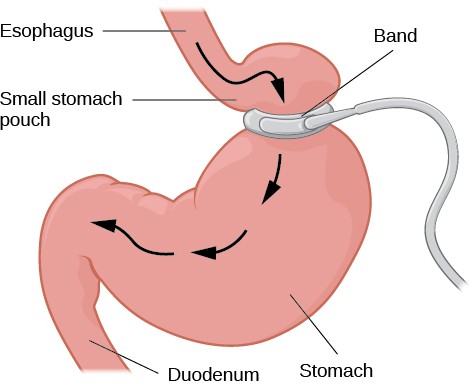
Figure 10.11 Gastric banding surgery creates a small pouch of stomach, reducing the size of the stomach that can be used for digestion.
EATING DISORDERS
While nearly two out of three US adults struggle with issues related to being overweight, a smaller, but significant, portion of the population has eating disorders that typically result in being normal weight or underweight. Often, these individuals are fearful of gaining weight. Individuals who suffer from bulimia nervosa and anorexia nervosa face many adverse health consequences (Mayo Clinic, 2012a, 2012b).
People suffering from bulimia nervosa engage in binge eating behavior that is followed by an attempt to compensate for the large amount of food consumed. Purging the food by inducing vomiting or through the use of laxatives are two common compensatory behaviors. Some affected individuals engage in excessive amounts of exercise to compensate for their binges. Bulimia is associated with many adverse health consequences that can include kidney failure, heart failure, and tooth decay. In addition, these individuals often suffer from anxiety and depression, and they are at an increased risk for substance abuse (Mayo Clinic, 2012b). The lifetime prevalence rate for bulimia nervosa is estimated at around 1% for women and less than 0.5% for men (Smink, van Hoeken, & Hoek, 2012).
As of the 2013 release of the Diagnostic and Statistical Manual, fifth edition, Binge eating disorder is a disorder recognized by the American Psychiatric Association (APA). Unlike with bulimia, eating binges are not followed by inappropriate behavior, such as purging, but they are followed by distress, including feelings of guilt and embarrassment. The resulting psychological distress distinguishes binge eating disorder from overeating (American Psychiatric Association [APA], 2013).
Anorexia nervosa is an eating disorder characterized by the maintenance of a body weight well below average through starvation and/or excessive exercise. Individuals suffering from anorexia nervosa often have a distorted body image, referenced in literature as a type of body dysmorphia, meaning that they view themselves as overweight even though they are not. Like bulimia nervosa, anorexia nervosa is associated with a number of significant negative health outcomes: bone loss, heart failure, kidney failure, amenorrhea (cessation of the menstrual period), reduced function of the gonads, and in extreme cases, death. Furthermore, there is an increased risk for a number of psychological problems, which include anxiety disorders, mood disorders, and substance abuse (Mayo Clinic, 2012a). Estimates of the prevalence of anorexia nervosa vary from study to study but generally range from just under one percent to just over four percent in women. Generally, prevalence rates are considerably lower for men (Smink et al., 2012).
While both anorexia and bulimia nervosa occur in men and women of many different cultures, Caucasian females from Western societies tend to be the most at-risk population. Recent research indicates that females between the ages of 15 and 19 are most at risk, and it has long been suspected that these eating disorders are culturally-bound phenomena that are related to messages of a thin ideal often portrayed in popular media and the fashion world (Figure 10.13) (Smink et al., 2012). While social factors play an important role in the development of eating disorders, there is also evidence that genetic factors may predispose people to these disorders (Collier & Treasure, 2004).

Figure 10.13 Young women in our society are inundated with images of extremely thin models (sometimes accurately depicted and sometimes digitally altered to make them look even thinner). These images may contribute to eating disorders. (credit: Peter Duhon)
Sexual Behavior
Learning Objectives
By the end of this section, you will be able to:
- Understand basic biological mechanisms regulating sexual behavior and motivation
- Appreciate the importance of Alfred Kinsey’s research on human sexuality
- Recognize the contributions that William Masters and Virginia Johnson’s research made to our understanding of the sexual response cycle
- Define sexual orientation and gender identity
Like food, sex is an important part of our lives. From an evolutionary perspective, the reason is obvious—perpetuation of the species. Sexual behavior in humans, however, involves much more than reproduction. This section provides an overview of research that has been conducted on human sexual behavior and motivation. This section will close with a discussion of issues related to gender and sexual orientation.
PHYSIOLOGICAL MECHANISMS OF SEXUAL BEHAVIOR AND MOTIVATION
Much of what we know about the physiological mechanisms that underlie sexual behavior and motivation comes from animal research. As you’ve learned, the hypothalamus plays an important role in motivated behaviors, and sex is no exception. In fact, lesions to an area of the hypothalamus called the medial preoptic area completely disrupt a male rat’s ability to engage in sexual behavior. Surprisingly, medial preoptic lesions do not change how hard a male rat is willing to work to gain access to a sexually receptive female (Figure 10.14). This suggests that the ability to engage in sexual behavior and the motivation to do so may be mediated by neural systems distinct from one another.
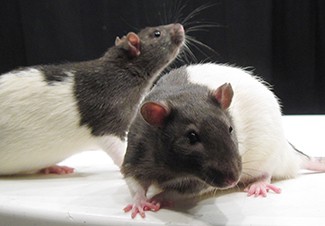
Figure 10.14 A male rat that cannot engage in sexual behavior still seeks receptive females, suggesting that the ability to engage in sexual behavior and the motivation to do so are mediated by different systems in the brain. (credit: Jason Snyder)
Animal research suggests that limbic system structures such as the amygdala and nucleus accumbens are especially important for sexual motivation. Damage to these areas results in a decreased motivation to engage in sexual behavior, while leaving the ability to do so intact (Figure 10.15) (Everett, 1990). Similar dissociations of sexual motivation and sexual ability have also been observed in the female rat (Becker, Rudick, & Jenkins, 2001; Jenkins & Becker, 2001).
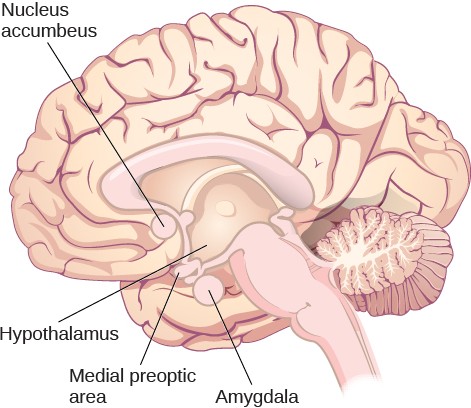
Figure 10.15 The medial preoptic area, an area of the hypothalamus, is involved in the ability to engage in sexual behavior, but it does not affect sexual motivation. In contrast, the amygdala and nucleus accumbens are involved in motivation for sexual behavior, but they do not affect the ability to engage in it.
Although human sexual behavior is much more complex than that seen in rats, some parallels between animals and humans can be drawn from this research. The worldwide popularity of drugs used to treat erectile dysfunction (Conrad, 2005) speaks to the fact that sexual motivation and the ability to engage in sexual behavior can also be dissociated in humans. Moreover, disorders that involve abnormal hypothalamic function are often associated with hypogonadism (reduced function of the gonads) and reduced sexual function (e.g., Prader-Willi syndrome). Given the hypothalamus’s role in endocrine function, it is not surprising that hormones secreted by the endocrine system also play important roles in sexual motivation and behavior. For example, many animals show no sign of sexual motivation in the absence of the appropriate combination of sex hormones from their gonads. While this is not the case for humans, there is considerable evidence that sexual motivation for both men and women varies as a function of circulating testosterone levels (Bhasin, Enzlin, Coviello, & Basson, 2007; Carter, 1992; Sherwin, 1988).
Emotion
Learning Objectives
By the end of this section, you will be able to:
- Explain the major theories of emotion
- Describe the role that limbic structures play in emotional processing
- Understand the ubiquitous nature of producing and recognizing emotional expression
As we move through our daily lives, we experience a variety of emotions. An emotion is a subjective state of being that we often describe as our feelings. The words emotion and mood are sometimes used interchangeably, but psychologists use these words to refer to two different things. Typically, the word emotion indicates a subjective, affective state that is relatively intense and that occurs in response to something we experience (Figure 10.20). Emotions are often thought to be consciously experienced and intentional. Mood, on the other hand, refers to a prolonged, less intense, affective state that does not occur in response to something we experience. Mood states may not be consciously recognized and do not carry the intentionality that is associated with emotion (Beedie, Terry, Lane, & Devonport, 2011). Here we will focus on emotion, and you will learn more about mood in the chapter that covers psychological disorders.
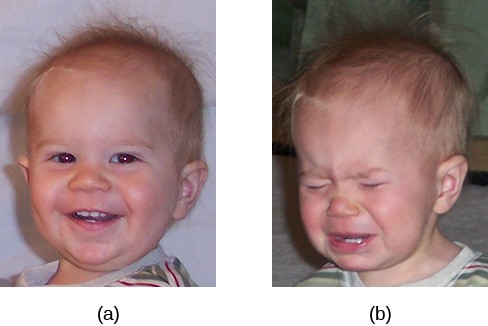
Figure 10.20 Toddlers can cycle through emotions quickly, being (a) extremely happy one moment and (b) extremely sad the next. (credit a: modification of work by Kerry Ceszyk; credit b: modification of work by Kerry Ceszyk)
We can be at the heights of joy or in the depths of despair or. We might feel angry when we are betrayed, fear when we are threatened, and surprised when something unexpected happens. This section will outline some of the most well-known theories explaining our emotional experience and provide insight into the biological bases of emotion. This section closes with a discussion of the ubiquitous nature of facial expressions of emotion and our abilities to recognize those expressions in others.
THEORIES OF EMOTION
Our emotional states are combinations of physiological arousal, psychological appraisal, and subjective experiences. Together, these are known as the components of emotion. These appraisals are informed by our experiences, backgrounds, and cultures. Therefore, different people may have different emotional experiences even when faced with similar circumstances. Over time, several different theories of emotion, shown in Figure 10.21, have been proposed to explain how the various components of emotion interact with one another.
The James-Lange theory of emotion asserts that emotions arise from physiological arousal. Recall what you have learned about the sympathetic nervous system and our fight or flight response when threatened. If you were to encounter some threat in your environment, like a venomous snake in your backyard, your sympathetic nervous system would initiate significant physiological arousal, which would make your heart race and increase your respiration rate. According to the James-Lange theory of emotion, you would only experience a feeling of fear after this physiological arousal had taken place. Furthermore, different arousal patterns would be associated with different feelings.
Other theorists, however, doubted that the physiological arousal that occurs with different types of emotions is distinct enough to result in the wide variety of emotions that we experience. Thus, the Cannon- Bard theory of emotion was developed. According to this view, physiological arousal and emotional experience occur simultaneously, yet independently (Lang, 1994). So, when you see the venomous snake, you feel fear at exactly the same time that your body mounts its fight or flight response. This emotional reaction would be separate and independent of the physiological arousal, even though they co-occur.
The James-Lange and Cannon-Bard theories have each garnered some empirical support in various research paradigms. For instance, Chwalisz, Diener, and Gallagher (1988) conducted a study of the emotional experiences of people who had spinal cord injuries. They reported that individuals who were incapable of receiving autonomic feedback because of their injuries still experienced emotion; however, there was a tendency for people with less awareness of autonomic arousal to experience less intense emotions. More recently, research investigating the facial feedback hypothesis suggested that suppression of facial expression of emotion lowered the intensity of some emotions experienced by participants (Davis, Senghas, & Ochsner, 2009). In both of these examples, neither theory is fully supported because physiological arousal does not seem to be necessary for the emotional experience, but this arousal does appear to be involved in enhancing the intensity of the emotional experience.
The Schachter-Singer two-factor theory of emotion is another variation on theories of emotions that takes into account both physiological arousal and the emotional experience. According to this theory, emotions are composed of two factors: physiological and cognitive. In other words, physiological arousal is interpreted in context to produce the emotional experience. In revisiting our example involving the venomous snake in your backyard, the two-factor theory maintains that the snake elicits sympathetic nervous system activation that is labeled as fear given the context, and our experience is that of fear.
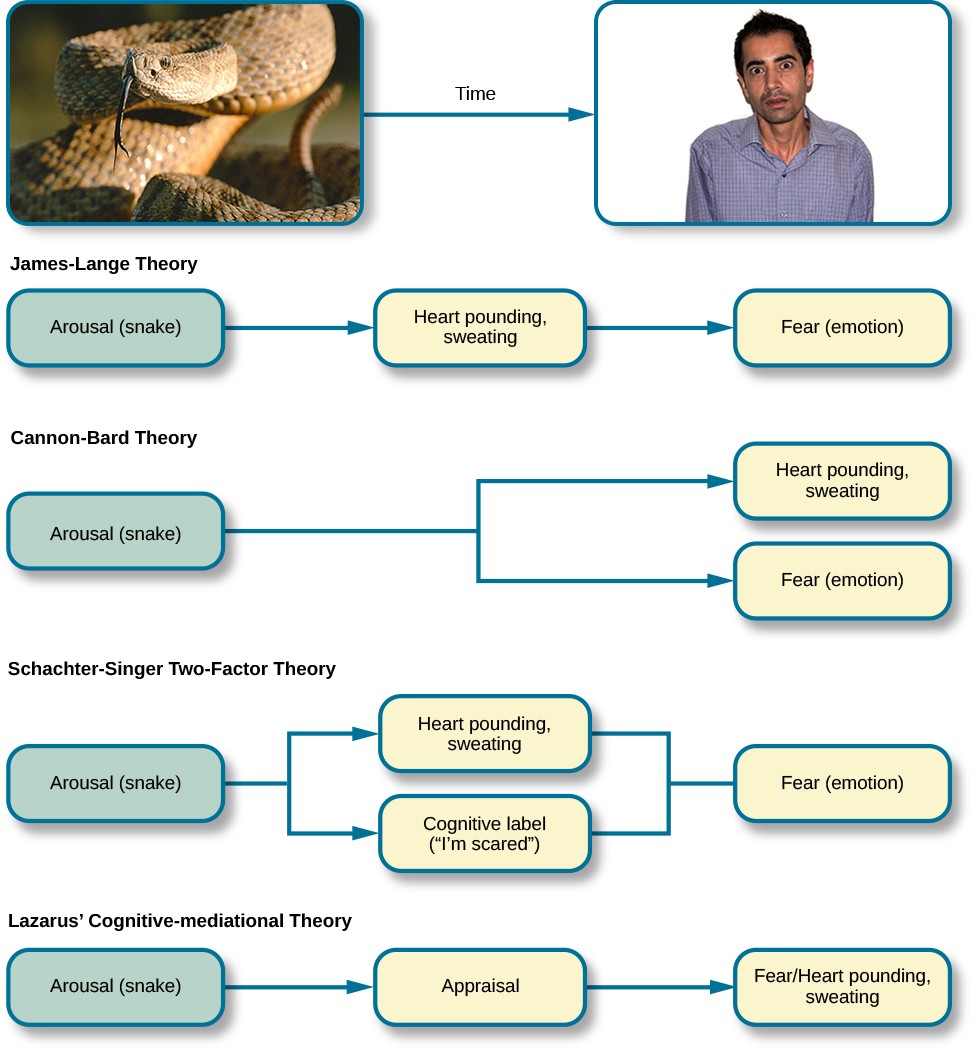
Figure 10.21 This figure illustrates the major assertions of the James-Lange, Cannon-Bard, and Schachter-Singer two-factor theories of emotion. (credit “snake”: modification of work by “tableatny”/Flickr; credit “face”: modification of work by Cory Zanker)
It is important to point out that Schachter and Singer believed that physiological arousal is very similar across the different types of emotions that we experience, and therefore, the cognitive appraisal of the situation is critical to the actual emotion experienced. In fact, it might be possible to misattribute arousal to an emotional experience if the circumstances were right (Schachter & Singer, 1962).
Strong emotional responses are associated with strong physiological arousal. This has led some to suggest that the signs of physiological arousal, which include increased heart rate, respiration rate, and sweating, might serve as a tool to determine whether someone is telling the truth or not. The assumption is that most of us would show signs of physiological arousal if we were being dishonest with someone. A polygraph, or lie detector test, measures the physiological arousal of an individual responding to a series of questions. Someone trained in reading these tests would look for answers to questions that are associated with increased levels of arousal as potential signs that the respondent may have been dishonest on those answers. While polygraphs are still commonly used, their validity and accuracy are highly questionable because there is no evidence that lying is associated with any particular pattern of physiological arousal (Saxe & Ben-Shakhar, 1999).
The relationship between our experiencing of emotions and our cognitive processing of them, and the order in which these occur, remains a topic of research and debate. Lazarus (1991) developed the cognitive-mediational theory that asserts our emotions are determined by our appraisal of the stimulus. This appraisal mediates between the stimulus and the emotional response, and it is immediate and often unconscious. In contrast to the Schachter-Singer model, the appraisal precedes a cognitive label. You will learn more about Lazarus’s appraisal concept when you study stress, health, and lifestyle.
Two other prominent views arise from the work of Robert Zajonc and Joseph LeDoux. Zajonc asserted that some emotions occur separately from or prior to our cognitive interpretation of them, such as feeling fear in response to an unexpected loud sound (Zajonc, 1998). He also believed in what we might casually refer to as a gut feeling—that we can experience an instantaneous and unexplainable like or dislike for someone or something (Zajonc, 1980). LeDoux also views some emotions as requiring no cognition: some emotions completely bypass contextual interpretation. His research into the neuroscience of emotion has demonstrated the amygdala’s primary role in fear (Cunha, Monfils, & LeDoux, 2010; LeDoux 1996, 2002). A fear stimulus is processed by the brain through one of two paths: from the thalamus (where it is perceived) directly to the amygdala or from the thalamus through the cortex and then to the amygdala. The first path is quick, while the second enables more processing about details of the stimulus. In the following section, we will look more closely at the neuroscience of emotional response.
THE BIOLOGY OF EMOTIONS
Earlier, you learned about the limbic system, which is the area of the brain involved in emotion and memory (Figure 10.22). The limbic system includes the hypothalamus, thalamus, amygdala, and the hippocampus. The hypothalamus plays a role in the activation of the sympathetic nervous system that is a part of any given emotional reaction. The thalamus serves as a sensory relay center whose neurons project to both the amygdala and the higher cortical regions for further processing. The amygdala plays a role in processing emotional information and sending that information on to cortical structures (Fossati, 2012).The hippocampus integrates emotional experience with cognition (Femenía, Gómez-Galán, Lindskog, & Magara, 2012).
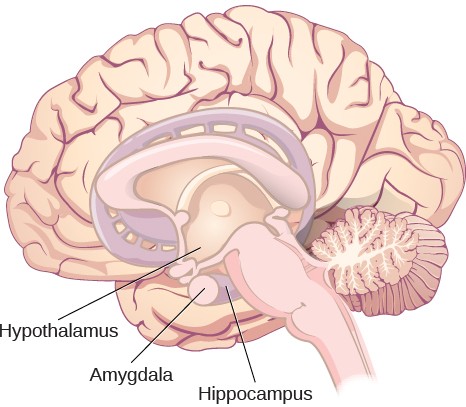
Figure 10.22 The limbic system, which includes the hypothalamus, thalamus, amygdala, and the hippocampus, is involved in mediating emotional response and memory.
Amygdala
The amygdala has received a great deal of attention from researchers interested in understanding the biological basis for emotions, especially fear and anxiety (Blackford & Pine, 2012; Goosens & Maren, 2002; Maren, Phan, & Liberzon, 2013). The amygdala is composed of various subnuclei, including the basolateral complex and the central nucleus (Figure 10.23). The basolateral complex has dense connections with a variety of sensory areas of the brain. It is critical for classical conditioning and for attaching emotional value to learning processes and memory. The central nucleus plays a role in attention, and it has connections with the hypothalamus and various brainstem areas to regulate the autonomic nervous and endocrine systems’ activity (Pessoa, 2010).
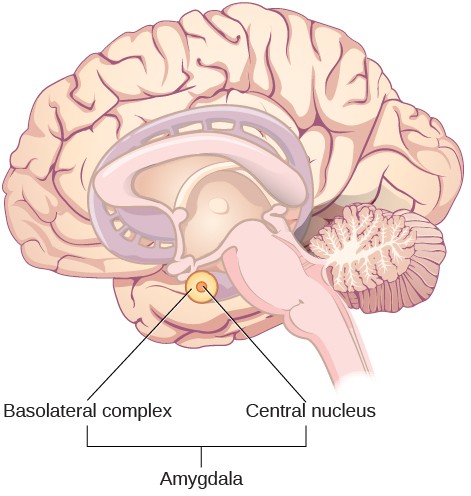
Figure 10.23 The anatomy of the basolateral complex and central nucleus of the amygdala are illustrated in this diagram.
Animal research has demonstrated that there is increased activation of the amygdala in rat pups that have odor cues paired with electrical shock when their mother is absent. This leads to an aversion to the odor cue that suggests the rats learned to fear the odor cue. Interestingly, when the mother was present, the rats actually showed a preference for the odor cue despite its association with an electrical shock. This preference was associated with no increases in amygdala activation. This suggests a differential effect on the amygdala by the context (the presence or absence of the mother) determined whether the pups learned to fear the odor or to be attracted to it (Moriceau & Sullivan, 2006).
Raineki, Cortés, Belnoue, and Sullivan (2012) demonstrated that, in rats, negative early life experiences could alter the function of the amygdala and result in adolescent patterns of behavior that mimic human mood disorders. In this study, rat pups received either abusive or normal treatment during postnatal days 8–12. There were two forms of abusive treatment. The first form of abusive treatment had an insufficient bedding condition. The mother rat had insufficient bedding material in her cage to build a proper nest that resulted in her spending more time away from her pups trying to construct a nest and less times nursing her pups. The second form of abusive treatment had an associative learning task that involved pairing odors and an electrical stimulus in the absence of the mother, as described above. The control group was in a cage with sufficient bedding and was left undisturbed with their mothers during the same time period. The rat pups that experienced abuse were much more likely to exhibit depressive-like symptoms during adolescence when compared to controls. These depressive-like behaviors were associated with increased activation of the amygdala.
Human research also suggests a relationship between the amygdala and psychological disorders of mood or anxiety. Changes in amygdala structure and function have been demonstrated in adolescents who are either at-risk or have been diagnosed with various mood and/or anxiety disorders (Miguel-Hidalgo, 2013; Qin et al., 2013). It has also been suggested that functional differences in the amygdala could serve as a biomarker to differentiate individuals suffering from bipolar disorder from those suffering from major depressive disorder (Fournier, Keener, Almeida, Kronhaus, & Phillips, 2013).
Hippocampus
As mentioned earlier, the hippocampus is also involved in emotional processing. Like the amygdala, research has demonstrated that hippocampal structure and function are linked to a variety of mood and anxiety disorders. Individuals suffering from posttraumatic stress disorder (PTSD) show marked reductions in the volume of several parts of the hippocampus, which may result from decreased levels of neurogenesis and dendritic branching (the generation of new neurons and the generation of new dendrites in existing neurons, respectively) (Wang et al., 2010). While it is impossible to make a causal claim with correlational research like this, studies have demonstrated behavioral improvements and hippocampal volume increases following either pharmacological or cognitive-behavioral therapy in individuals suffering from PTSD (Bremner & Vermetten, 2004; Levy-Gigi, Szabó, Kelemen, & Kéri, 2013).
LINK TO LEARNINGWatch this video (http://openstaxcollege.org/l/traumaticexp) about research that demonstrates how the volume of the hippocampus can vary as a function oftraumatic experiences.
FACIAL EXPRESSION AND RECOGNITION OF EMOTIONS
Culture can impact the way in which people display emotion. A cultural display rule is one of a collection of culturally specific standards that govern the types and frequencies of displays of emotions that are acceptable (Malatesta & Haviland, 1982). Therefore, people from varying cultural backgrounds can have very different cultural display rules of emotion. For example, research has shown that individuals from the United States express negative emotions like fear, anger, and disgust both alone and in the presence of others, while Japanese individuals only do so while alone (Matsumoto, 1990). Furthermore, individuals from cultures that tend to emphasize social cohesion are more likely to engage in suppression of emotional reaction so they can evaluate which response is most appropriate in a given context (Matsumoto, Yoo, & Nakagawa, 2008).
Other distinct cultural characteristics might be involved in emotionality. For instance, there may be gender differences involved in emotional processing. While research into gender differences in emotional display is equivocal, there is some evidence that men and women may differ in regulation of emotions (McRae, Ochsner, Mauss, Gabrieli, & Gross, 2008).
Despite different emotional display rules, our ability to recognize and produce facial expressions of emotion appears to be universal. In fact, even congenitally blind individuals produce the same facial expression of emotions, despite their never having the opportunity to observe these facial displays of emotion in other people. This would seem to suggest that the pattern of activity in facial muscles involved in generating emotional expressions is universal, and indeed, this idea was suggested in the late 19th century in Charles Darwin’s book The Expression of Emotions in Man and Animals (1872). In fact, there is substantial evidence for seven universal emotions that are each associated with distinct facial expressions. These include: happiness, surprise, sadness, fright, disgust, contempt, and anger (Figure 10.24) (Ekman & Keltner, 1997).

Figure 10.24 The seven universal facial expressions of emotion are shown. (credit: modification of work by Cory Zanker)
Does smiling make you happy? Or does being happy make you smile? The facial feedback hypothesis asserts that facial expressions are capable of influencing our emotions, meaning that smiling can make you feel happier (Buck, 1980; Soussignan, 2001; Strack, Martin, & Stepper, 1988). Recent research explored how Botox, which paralyzes facial muscles and limits facial expression, might affect emotion. Havas, Glenberg, Gutowski, Lucarelli, and Davidson (2010) discovered that depressed individuals reported less depression after paralysis of their frowning muscles with Botox injections.
Of course, emotion is not only displayed through facial expression. We also use the tone of our voices, various behaviors, and body language to communicate information about our emotional states. Body language is the expression of emotion in terms of body position or movement. Research suggests that we are quite sensitive to the emotional information communicated through body language, even if we’re not consciously aware of it (de Gelder, 2006; Tamietto et al., 2009).
Summary
Motivation
Motivation to engage in a given behavior can come from internal and/or external factors. Multiple
theories have been put forward regarding motivation. More biologically oriented theories deal with the ways that instincts and the need to maintain bodily homeostasis motivate behavior. Bandura postulated that our sense of self-efficacy motivates behaviors, and there are a number of theories that focus on a variety of social motives. Abraham Maslow’s hierarchy of needs is a model that shows the relationship among multiple motives that range from lower-level physiological needs to the very high level of self- actualization.
Hunger and Eating
Hunger and satiety are highly regulated processes that result in a person maintaining a fairly stable weight that is resistant to change. When more calories are consumed than expended, a person will store excess energy as fat. Being significantly overweight adds substantially to a person’s health risks and problems, including cardiovascular disease, type 2 diabetes, certain cancers, and other medical issues. Sociocultural factors that emphasize thinness as a beauty ideal and a genetic predisposition contribute to the development of eating disorders in many young females, though eating disorders span ages and genders.
Sexual Behavior
The hypothalamus and structures of the limbic system are important in sexual behavior and motivation. There is evidence to suggest that our motivation to engage in sexual behavior and our ability to do so are related, but separate, processes.
Emotion
Emotions are subjective experiences that consist of physiological arousal and cognitive appraisal. Various theories have been put forward to explain our emotional experiences. The James-Lange theory asserts that emotions arise as a function of physiological arousal. The Cannon-Bard theory maintains that emotional experience occurs simultaneous to and independent of physiological arousal. The Schachter-Singer two- factor theory suggests that physiological arousal receives cognitive labels as a function of the relevant context and that these two factors together result in an emotional experience.
The limbic system is the brain’s emotional circuit, which includes the amygdala and the hippocampus. Both of these structures are implicated in playing a role in normal emotional processing as well as in psychological mood and anxiety disorders. Increased amygdala activity is associated with learning to fear, and it is seen in individuals who are at risk for or suffering from mood disorders. The volume of the hippocampus has been shown to be reduced in individuals suffering from posttraumatic stress disorder.
The ability to produce and recognize facial expressions of emotions seems to be universal regardless of cultural background. However, there are cultural display rules which influence how often and under what circumstances various emotions can be expressed. Tone of voice and body language also serve as a means by which we communicate information about our emotional states.
